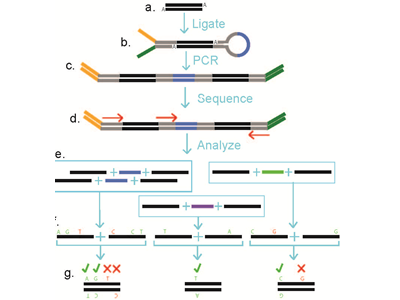Efficient Duplex Sequencing Using High Fidelity Next Generation Sequencing Reads
The innovation is a library preparation technique that produces an error-corrected nucleic acid library for sequencing.

What is the Problem?
Next-generation DNA sequencing (NGS) revolutionized the field of genomics and personalized medicine and has been used to scalably identify disease-relevant mutations. However, existing sequencing technologies are limited in application by a relatively high error rate, making it difficult to identify low-prevalence mutations. Duplex sequencing uses degenerate unique molecular identifiers (UMIs) to label library fragments, followed by redundant sequencing of each fragment at high depth to produce an error-corrected consensus. Since UMI-mediated approaches require an excessive number of sequencing reads in order to identify mutations, they are limited in scalability and cost-prohibitive for many applications. Thus there is a need for fast, inexpensive, and accurate sequencing approaches that leverage the power of NGS.
What is the Solution?
The solution is a library preparation technique that produces an error-corrected nucleic acid library for sequencing. The method is developed for the Omniome sequencer but is generalizable to other high fidelity next generation sequencers. Linked duplex sequencing is a novel experimental framework wherein two strands of DNA are covalently joined from an initial template fragment by a linker adapter. The resulting duplex provides a single molecule template for sequencing, such that error correction of the duplex can be performed comparing the two linked strands and only variation observed in both are accepted as true mutations. A UMI can be optionally incorporated when interrogating molecules mapping to the same genomic location or to allow more robust elimination of PCR duplicates from randomly sheared DNA.
What is the Competitive Advantage?
The competitive advantage of this technology lies in its ability to provide increased NGS read fidelity so that it does not require excessive read depth. The strategy presented here has the advantages of scalability, cost-effectiveness, ease of use, efficiency, and sensitivity. Due to its higher accuracy and lower error rates, this method can be used to detect low-prevalence mutations, thus greatly advancing sequencing capabilities in the genomics field. As the global DNA sequencing market size is valued at $8.9 billion in 2022 with an expected CAGR of 20.7%, there is a significant opportunity for this technology to advance the field of sequencing technologies.